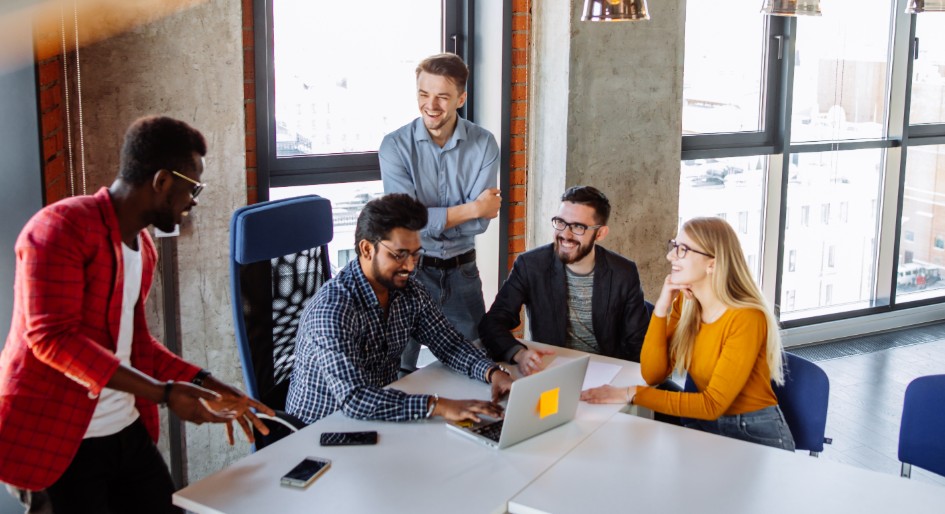Humans are naturally social creatures that crave social spaces. So why shouldn’t our built environment be designed to accommodate and encourage this natural state of being?
A company’s office environment and culture is just as important as the work the business produces. With the increased popularity of wellbeing in workplace design, it has become common practice to create physical environments that positively impact mental health and increase employee productivity.
Due to this shift, private cubicles and offices have significantly decreased, as newly-designed office spaces have opted for open floor plans that prioritize social spaces. Consequently, designers have had to find solutions for defining spaces through the careful curation of flexible contract furniture. With the recent COVID-19 pandemic, social spaces are having to readapt to suit new health and safety needs. With flexible furniture options, an office can be easily restructured to provide a safe environment while still keeping an open and social space for employees to work and socialize.
Understanding the benefits of socializing
With the recent shift to working from home, many are missing the connection and socialization they shared with their co-workers in the same way they did pre-COVID-19. It is human nature to want to tap into the emotions of those around us. As we look to return to the office in a safe manner, designing and outfitting offices with the right furniture must consider how to optimize the space to accommodate myriad work and socialization styles, as well as personal safety and health.
A recent study conducted by Gallup, an American analytics and advisory company, found that women who had a best friend in the office were twice as engaged as women who did not have a work friend. Because of the personal connection, these employees were less likely to change jobs, and likely to create trusting relationships throughout their employee network, which lead to greater well-being and productivity throughout teams.
Through the use of a smart and safe open concept floor plan, employees are able to experience more face time with coworkers, allowing them opportunities to chat, collaborate, and cultivate a sense of community. By implementing new distance requirements and furniture solutions, people can still achieve this time together while remaining safe to themselves and to others. Another common concern with office space design is how acoustics will affect workflow—especially for employees who work better with minimal noise distractions.
Breakout and common spaces allow those who prefer casual chatting or brainstorming with coworkers to move away from the main hub of employees and work, while not distracting those who prefer to stay at a more traditional desk space. These areas consisting of flexible modular seating units enable this type of collaborative work and also make it possible for employees to move away from loud groups, to do solo work in a private pod or high-back lounge chair. These flexible, simple solutions help to mitigate sound, provide added privacy, and increase safety between employees.
Embracing differences
The study of neurodiversity is the awareness of stark or subtle differences in how each individual’s brain functions. This approach understands that every human is unique, and the day-to-day choices they make are susceptible to change at any time. With this in mind, it’s easy to see that a stationary workstation solution will not work for everyone.
To help create functional and adaptable spaces, the workplace designers have looked to other sectors for help. Recently, the concept of neurodiversity has been applied to school facility designs in order to help students thrive in different academic environments. As a result, there has been an increased focus on creating continuity between the types of work settings students use in schools, and those they will likely find themselves in after graduation.
If we never stop learning, why should the spaces we inhabit after graduation not take queues from environments specially tailored toward intellectual stimulation? Now that workplace design is being influenced by academic institutions, neurodiversity has found its way into the everyday office and companies are embracing the variety of work, learning, and focus styles that come with hiring a diverse workforce.
The freedom of an agile workspace
Breakout spaces aren’t solely about creating common areas for collaboration. In fact, employers have noticed an influx of conference room bookings due to the challenges posed by open office spaces. These curated areas that can be defined by the right furnishings are also intended to provide respite for employees who need some quiet time, a private phone chat or a place to focus on a challenging task. As we prepare to return to the office, employers are set to expect a significant decrease in office occupancy. These breakout spaces can also serve as flexible work stations for people who choose to not come into the office full time. Rather than filling the office with unused desks, breakout spaces can provide an employee with a space to work that can easily be cleaned when they leave and used by another employee on another day.
Post-pandemic social spaces
Social spaces in offices have taken a new meaning in the post-COVID-19 workplace. There will be a surge in removing personal workstations and the creation of personal storage for employees to easily pack up and set up wherever they like, be that in the office or at home.
By creating a versatile and highly flexible space for employees to come to, they can quickly design their own environments for what works best for their work styles. With furniture options like easily moveable tables, walls, and seats, as well as a wide array of adaptable furniture configurations—from sofas to chairs with writing desks—employees have the freedom to select the most comfortable solution based on the project or time of day. Without personal stations, furniture can easily be cleaned at the end of the day and used by someone the next day without fear of unclean stations.
Charlie Bell is the president of Studio TK. Bell has over 30 years of experience in the contract furniture industry.




